Here’s an interesting thought:
Craft beer in North America went through a lot of growing pains on the way to being where they are at the moment. There were years of struggling to make English styles of beer as authentically as possible (hard to do in San Francisco) and the advent and proliferation of C-Hops. By the time you get to about 2010, the fruits of those labours have more or less paid off as the craft beer trend went global. Suddenly there are hops from New Zealand and the C-Hops have blossomed into widespread Double IPAs. You’ve got hop varieties that are great at not just citrus and pine, but all manner of tropical fruit and mineral elements.
The thing is that this kind of innovation, if perpetuated on a long enough timeline, brings old ideas with it as well as new tools and equipment. If you introduced your flagship pale ale in 1994 and it was considered to be pretty hoppy at that point, you’re unlikely to be able to change the recipe without compromising your market share or really pissing off your earliest customers. There’s such a thing as 90’s beer. It still exists in Toronto. If you have The Beer Academy’s IPA, it’s more or less exactly what I’m talking about. It’s quite good, mind you, but it is so old school that it wears a striped tie.
In London, there was no craft beer scene until about 2007. I’m not choosing that date arbitrarily. That was the year that The Rake in Borough Market opened for business. Before 2007 there were a couple of what might be considered small breweries dotted around the country. Dark Star is a good example of this. They opened in 1994 and you really get that sense from their Hophead on cask. Again, really a very good beer, but the Cascade hops are unmistakeable. It’s of an era.
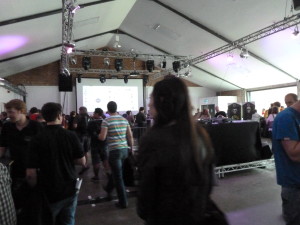
See? There’s a DJ booth.It’s a proper modern beer festival. Apparently Craig Charles was going to be DJing at some point. It’s just as well I didn’t meet him because I would have been forced to offer a hearty “boys from the dwarf” in greeting.
The number that I heard bandied about at the inaugural London Craft Beer Festival at the Oval Space in Hackney on Friday was 50. Over the last five years or so, there have been 50 brewery startups in London. They’ve all come into existence during the height of the international craft beer trend, many of them within the last six months. This means two things:
1) They don’t have as much of the conceptual baggage that you might have in an older scene.
2) Because of point one, they’re now doing really interesting cutting edge stuff.
A really neat thing about starting a brewery from scratch is that you get to come up with all new branding and a cohesive concept upon which to base your products. You have a template from which to work which seems completely contemporary. You also don’t have the baggage of existing brands that you have to continue making. Because of that, you can introduce a flagship brand or choose not to. Rather than being beholden to older hop varieties, you can choose to use the new stuff whenever possible. Beer styles? Out the window. Screw ‘em.
I’m at least putatively on vacation, so I’m going to hit the highlights of what I saw on Friday at the London Craft Beer Festival. Incidentally, I’m extraordinarily lucky to have been able to fit all of this into one week. You have to imagine that scheduling the London Craft Beer Festival during the Great British Beer Festival is not so much happenstance as a direct assault. This is a vastly different crowd and I think it can be summed up by the t-shirts from the Weird Beard Brewing Co. This is more representative of a younger demographic in London, brewing in rail arches and warehouses.
One of the points that cropped up repeatedly is that you can’t have a scene emerge this quickly out of thin air. I had never really understood, prior to Friday, the sort of influence that Gypsy brewers were having. For one thing, they’ve only made it to Toronto in the last couple of years. We’ve got Anders Kissmeyer working with Beau’s and Evil Twin popping up at Bellwoods periodically. In the case of the London scene I feel like the gypsy brewers have been instrumental in making progress happen this quickly. Mikkeller had a booth as did To Ol.
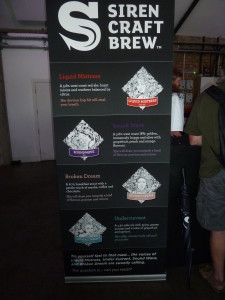
Clever conceptual branding here from Siren, working the mythology to advantage. I’d eventually like to see a beer called Odyssey, or possibly Screaming Argonaut.
One of the most impressive breweries on site was Siren Craft Brew. I’m given to understand that their head brewer, Ryan, did a lot of brewing for Evil Twin and Mikkeller prior to his current gig at Siren. This shows through in a number of ways. First of all, there’s the willingness to experiment. Broken Dream is a 6.5% Breakfast Stout with coffee and lactose and I’d have been happy to get that anywhere in the world. Second of all, there’s the obvious potential for collaborative effort with contacts you’d make as a gypsy brewer. Not only was there a very interesting beer called Limoncello (lemon zest, lemon juice, sour mash, lactose) that was brewed in collaboration with Hill Farmstead and Mikkeller, but apparently there’s a version of Broken Dream out there aged in Pappy Van Winkle barrels. You don’t get your hands on those if you’re just some guy.
So, now I understand what gypsy brewers do: They are conceptual cross-pollinators. They have a top down view and manage to get bits of information (and sometimes rare bourbon barrels) from over here to over there. Groovy.
Another significant strength of the craft beer scene here is that they don’t seem overmuch worried by stylistic definitions. Buxton, for instance, had come up with something that I haven’t seen before for the festival. Called Wolfescoate, it’s a 3.3% beer, black as night with a whole lot of lactic sourness. I believe the rep told me that it had been soured in copper for four days. In order to highlight the sourness, they’ve decided to omit any hops. “So it’s a gruit?” I can hear you say. No. They haven’t replaced the hops with herbs. Instead of using bitterness to balance their beer, they’ve chosen to balance it with the roast from the malt. The result is pretty amazing.
Additionally, there seems to be a trend toward something like a very small version of an India Pale Ale. Magic Rock (from Huddersfield in Yorkshire) and The Kernel (from near Bermondsey Tube Station) have both gone in the direction of brewing very small beer indeed. Magic Rock’s is called Simpleton and sat at around 2.5% alcohol. The significant Citra hop nose is something you wouldn’t see at that strength very frequently. Somehow it retains a full body. There’s not much room for error here and Magic Rock manages it very nicely. The Kernel has a Table Beer (which, to be fair, I had at The Rake) which claimed 2.7% alcohol and was packed full of Nelson Sauvin.
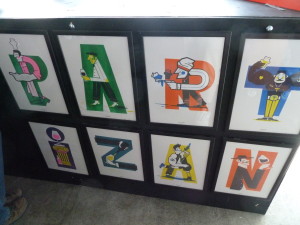
Some of the London brewers have really done extraordinarily well in terms of branding. Partizan is at the forefront with their whimsical lettering.
This is a really pleasant range. You get all the hop character without malt or alcohol getting in the way. The bitterness is quite mild because it has to be. It would overwhelm very quickly beyond a certain point. It is pronounced in terms of balance within the beer, but not in terms of comparison to a 5% Pale Ale. I suspect you could spend the entire afternoon drinking beer of this style, appreciate them as a connoisseur and walk away from the experience stone cold sober. I like the idea so much I’m going to thieve it.
Among the other highlights here were Redemption’s Rock The Kazbek (lemon, lime, slight hint of drying paint), Weird Beard’s Mariana Trench (it’s a solid, tropical fruity pale ale), Partizan’s Saison (Quite dry, very refreshing) and Brodie’s Hoxton. Thornbridge’s Kolsch TZARA is pretty excellent, especially since my context for that brewery is Kipling and Jaipur. Also worth mentioning is Crate, who have produced a stout that inexplicably uses a hefeweizen yeast. Neat idea. It results in Chocolate/Banana. The brewer was quite forthright about having come to it by accident, but I’m still going to give him credit for sticking with the thing.
The only difficulty I foresee for the London scene is that because so many of them are using the same hop varieties in the same types of beers (there are a lot of galaxy/citra/nelson sauvin pale ale type beers) that there will eventually be a lot of overlap between different breweries on some styles. If I were them I’d be planning accordingly to differentiate myself a little.
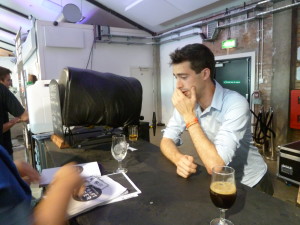
As with any relaxed craft beer festival, you get the opportunity to talk to the brewers at some length.
The good news is that London’s scene is going to be coming to Canada in relatively short order. This year Cask Days is having a number of English brewers over for a special part of the annual Cask Days event. I suppose it had been announced, but it was interesting to talk to Andy from Redemption and hear that he was sending cask to Canada. The brewers who mentioned it all seemed a little confused that their beer should be in such demand, especially from Toronto. If what I saw this week is any indication, Ralph and the boys should probably double the order.
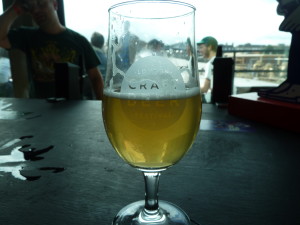

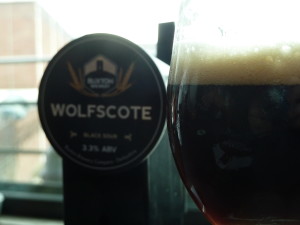
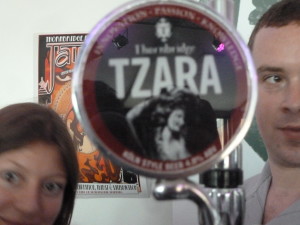

Excellent report Jordan, and would be interested in your further thoughts on this subject. It sounds like the London scene is hearty and diverse. My recollection is that before 2007, there were a number of craft operations and brewpubs in London including Freedom (lager brewing only at the time), Porterhouse in Covent Garden, Pitfield Brewing which started in the early 80’s, Mash on Great Portland Road and various Firkin pubs (the David Bruce-originated chain). These were all worthy and some still exist today in altered form or outside London.
It’s an interesting question why this group was relatively small. One reason I think was that Young’s still existed then and made such good beers. With Fuller’s and various cask beers brought to London from established companies outside, e.g. Courage, Shepeard Neame, Gales, Adnams, Ruddles, you had a good selection of real ales. Well, Young’s stopped brewing in the capital, some of the smaller old companies outside London closed or were taken over, and Jackson passed away in 2007 (with national attention being given the latter). After these events I think the city just became more conscious of the need to secure good beer. And/or the U.S. fashion finally hit big. Maybe it’s “all of the above”.
Interesting that the range covered by the newbies sounds so similar to what we see here. I hope they will also make beers with more traditional English tastes since these were really the glory of English brewing, or IMO.
Gary
Good stuff, Jordan. Informative for those of us who think still think England is in the thrall of the whole whippet-and-cloth-cap-if-it-isn’t-cask-ale-it’s-no-better-than-Watney’s-Red-Barrel-CAMRA-shtick. (That was murder to hyphenate.)